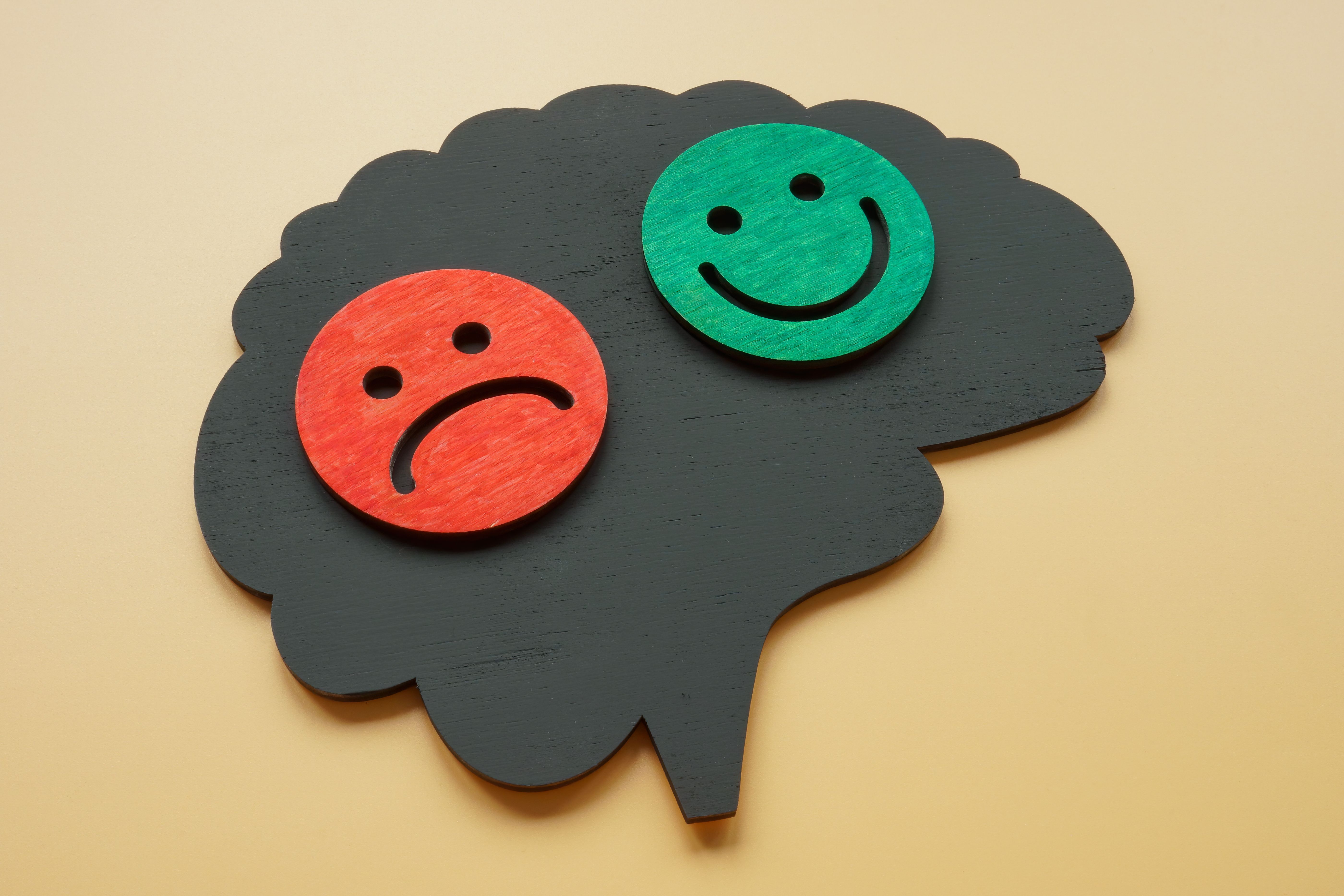Blog
Article
To Be or Not to Be? Understanding False Positives in Bipolar Diagnosis
The context and timing of symptoms is critical for a timely and accurate bipolar diagnosis.
Axel Bueckert/AdobeStock

CLINICIAN’S CORNER
“Knowledge without context is confusion.”
-Chuck D, Public Enemy
Understanding the context and timing of symptoms is critical to making a timely and accurate bipolar diagnosis. Unfortunately, the context and timing of symptoms are often overlooked. The delay from onset of symptoms to bipolar diagnosis is 10 years on average.1 This underdiagnosis or delay of diagnosis of bipolar has often been made when the person's index presentation for psychiatric evaluation is during a depressive episode. Every person presenting with symptoms of depression must be, at a minimum, evaluated for previous symptoms of mania or hypomania (occurring in the absence of substance use) and familial history of bipolar illness.
Understanding the broader context of the person's presentation and not accepting depressive symptoms at face value can reduce diagnostic errors and delays in appropriate medication management. Underdiagnosis and overdiagnosis of bipolar illness can both be attributed to inadvertently dismissing or attributing symptoms that occur during teen years and early 20s (the average age of onset for bipolar illness) as developmentally normal. It is important to determine that the presenting symptoms are a stark change from baseline.1 Late adolescence and early adulthood are times when impulsivity, irritability, risk-taking, poor sleep, and recreational substance use are pervasive. Data are trending towards a recent phenomenon of overdiagnosis of bipolar illness in certain settings.2-4 Anecdotally, some argue that the increase is not due to incorrect diagnosis or overdiagnosis, but an increase in appropriate screening. Others have balked at the increase and attributed the trend to undue patient influence via Google and wholesale misdiagnosis. Although not diagnostic, validated screening instruments can help frame the conversation of presenting symptoms and ensure that important context is not overlooked.
Screenings are not diagnostic. In psychiatry, clinicians often fall into 2 categories: those who use validated screening instruments and those who do not. Research indicates that less than 20% of behavioral health practitioners utilize measurement-based care.5 The low utilization of rating scales is multi-factorial. It includes provider concerns for patient confidentiality, competing requirements of insurance and medical records, and a belief that clinical judgment is suitable.5 Using clinical judgment alone, providers detected early deterioration in only 21.4% of patients.6 Clinical incorporation of measurement-based care may reduce deterioration by 4% to 8% and improve positive outcomes.7
Self-report patient assessments are a valuable tool, but these rating scales must be seen as the first step in a 2-stage process. If the screening is positive, a more definitive and extensive evaluation is warranted. A good screening instrument will detect almost all patients with the disorder (high sensitivity) and rule out the disorder for almost all patients who screen negative (high negative predictive value). While high specificity or high positive predictive value is less critical for screening, an effective screener helps clinicians identify almost all patients who need further evaluation for the disorder (Table 1). To reduce false positive diagnoses, clinicians must uphold screening as a 2-stage process. In busy clinical practices, it is tempting to take a positive screener as diagnostic confirmation.
Table 1. Screening

One of the great challenges for patients and clinicians alike is the prevalence of cooccurring substance use for those living with bipolar illness. Current literature has a prevalence of cooccurring substance use ranging from 30% to 50%.1,8 If we can ascertain that the timing and context of symptoms were present before the substance use then the bipolar diagnosis is not complicated to make; however, the timing and context are often not so clearly defined. Further, other differentials and comorbidities such as borderline personality disorder and attention-deficit/hyperactivity disorder (ADHD) must also be ruled out. There are other contextual clues that can further inform our differential in the absence of clear history of manic or hypomanic features. A few scenarios that would prompt medication management consistent with the treatment for bipolar illness rather than unipolar depression (mood stabilizers and dopamine receptor blocking agents vs SSRI/SNRI), despite not meeting all DSM-5 diagnostic criteria:
- Patient has the genetic pedigree of multiple first and second-degree relatives with type 1 bipolar illness and reports the first onset of depression at age 8 in the absence of any lifetime trauma, bullying, or loss.
- Patient has a history of postpartum depression and an immediate response (within 48 hours) to an SSRI.
That is not to say that these scenarios then rate a bipolar diagnosis; they do not. The patient must continue to be followed, and the longitudinal monitoring of symptoms noted. The context suggests that there is high suspicion for bipolar illness and the patient would likely benefit from a more nuanced approach to their medication management.
Reducing false positives in the diagnosis of bipolar disorder requires careful consideration and implementation of key principles. Although bipolar disorder carries distinct diagnostic criteria, clinicians may misdiagnose a patient due to phenomenological overlap with other symptoms (Table 2). For instance, patients misdiagnosed with bipolar disorder are more likely to carry features of borderline personality disorder.9 A comprehensive assessment, utilizing a semi-structured clinical interview remains the gold standard for the diagnosis of bipolar disorder. However, busy clinicians may have to balance thorough clinical assessments against practice settings with limited time and resources. Self-report rating scales can help clinicians identify patients who require a more thorough assessment.
Table 2. Symptom Overlap1,4,8,9

Another key principle in reducing the misdiagnosis of bipolar disorder is to reject the pressure to assign a bipolar diagnosis immediately. Mania/hypomania is rarely an index presentation in bipolar disorder. This means that most patients will present in psychiatric clinics with complaints of depression that are indistinguishable from unipolar depression. Longitudinal monitoring of patients’ symptoms can provide clarity of diagnosis. For example, if the patient’s cognitive complaints are persistent regardless of affective state, this may suggest a comorbid psychiatric diagnosis while cognitive dysfunction within the context of a mood episode may be suggestive of bipolar illness.
Lastly, clinicians should take care to remember that medication response is not diagnostic. Often, clinicians may update a diagnosis based on a response to a new medication class. For example, a positive response to lithium augmentation in a refractory depression may tempt a new diagnosis of bipolar disorder in light of this positive response. Lithium and second-generation antipsychotics are effective augmenting agents in unipolar depression.10 Clinicians may also be tempted to convert to a bipolar diagnosis if a patient experiences irritability or agitation with an antidepressant trial. The use of antidepressants does not convey any diagnostic implications unless the patient experiences a manic switch.11 One of the more significant updates to bipolar diagnostic criteria between the DSM-IV to DSM-5 is the inclusion of antidepressant-induced mania as diagnostically sufficient provided that it is temporal and persists at a fully syndromal level.12 An antidepressant-induced manic episode is one of the few circumstances where a diagnostic change is informed by medication response.
Just as bipolar disorder is both overdiagnosed and underdiagnosed, psychiatry has a similar relationship with diagnostic fidelity. In school, students are often taught a rigid adherence to diagnostic criteria, but early career clinicians frequently enter a clinical environment of ambiguity, symptom overlap, and diagnostic uncertainty. Early career clinicians must understand how diagnosis informs treatments, prognosis, and nearly every other aspect of care. Psychiatry remains a field of syndromes, meaning a group of signs and symptoms with known associated features that characterize a particular disorder. In the absence of biomarkers or other definitive testing, a careful and accurate diagnosis remains one of the most critical components of psychiatry.
There has been increasing awareness and attention spent on the underdiagnosis of bipolar disorder. A delay in bipolar diagnosis may contribute to many adverse outcomes. However, our efforts to increase awareness of bipolar disorder must not overcorrect. Overdiagnosis of bipolar disorder poses significant challenges in mental health care, leading to inappropriate treatment and mismanagement of other underlying conditions. By understanding the limitations of screening instruments, recognizing the impact of comorbidities, and adhering to key principles in diagnostic assessment, clinicians can improve diagnostic accuracy. A careful and nuanced approach ensures that individuals receive appropriate and effective care, tailored to their specific needs.
Dedicated to early career clinicians, Clinician’s Corner aims to provide helpful information in an approachable and supportive manner. If you have topics that you would like Drs Asbach and Roque to discuss, please submit suggestions to PTEditor@mmhgroup.com.
Ms Roque is a clinical associate professor in the Hahn School of Nursing and Health Science at the University of San Diego. Mr Asbach is a psychiatric physician associate and serves as associate director of interventional psychiatry at DENT Neurologic Institute in New York.
References
1. Bipolar and related disorders. In: Diagnostic and Statistical Manual of Mental Disorders, 5th ed, Text Rev. American Psychiatric Association; 2022:139-159.
2. Stewart C, El-Mallakh RS. Is bipolar disorder overdiagnosed among patients with substance abuse? Bipolar Disord. 2007;9(6):646-648.
3. Zimmerman M, Ruggero CJ, Chelminski I, Young D. Is bipolar overdiagnosed? J Clin Psychiatry. 2008;69(6):935-940.
4. Zimmerman MA. A review of 20 years of research on overdiagnosis and underdiagnosis in the Rhode Island Methods to Improve Diagnostic Assessment and Services (MIDAS) Project. Can J Psychiatry. 2016;61(2):71-79.
5. Lewis CC, Boyd M, Puspitasari A, et al. Implementing measurement-based care in behavioral health: a review. JAMA Psychiatry. 2019;76(3):324-335.
6. Hatfield D, McCullough L, Frantz SH, et al. Do we know when our clients get worse? An investigation of therapists’ ability to detect negative client change. Clin Psychol Psychother. 2010;17(1):25-32.
7. Lambert MJ, Whipple JL, Hawkins EJ, et al. Is it time for clinicians to routinely track patient outcome? A meta-analysis. Clin Psychol. 2006;10(3):288-301.
8. Cerullo MA, Strakowski SM. The prevalence and significance of substance use disorders in bipolar type I and II disorder. Subst Abuse Treat Prev Policy. 2007;2:29.
9. Ruggero CJ, Zimmerman M, Chelminski I, Young D. Borderline personality disorder and the misdiagnosis of bipolar disorder. J Psychiatr Res. 2010;44(6):405-408.
10. Vázquez GH, Bahji A, Undurraga J, et al. Efficacy and tolerability of combination treatments for major depression: antidepressants plus second-generation antipsychotics vs. esketamine vs. lithium. J Psychopharmacol. 2021;35(8):890-900.
11. Pacchiarotti I, Bond DJ, Baldessarini RJ, et al. The International Society for Bipolar Disorders (ISBD) task force report on antidepressant use in bipolar disorders. Am J Psychiatry. 2013;170(11):1249-1262.
12. Substance Abuse and Mental Health Services Administration. DSM-5 changes: implications for child serious emotional disturbance [Internet]. Substance Abuse and Mental Health Services Administration. 2016.






